Wim van Bochoven's Superior Mirage
Introduction
Wim van Bochoven, who took these pictures, tells how he happened to see
this display, on May 22, 2002:
We sailed the famous
Hurtigruten
('the worlds most beautiful voyage') from Bergen to Kirkenes and back
in 12 days....
On this particular and beautiful day we left Stamsund (Lofoten) heading for
Bodø on the mainland of Norway.
[ATY remarks: That puts him about 68° North.]
I took, standing on the back of the boat, 10 to 15 meters above sealevel,
some pictures of the sun, which was sinking behind the mountains.
The weather was clear, almost no wind. It had been a very nice and warm day.
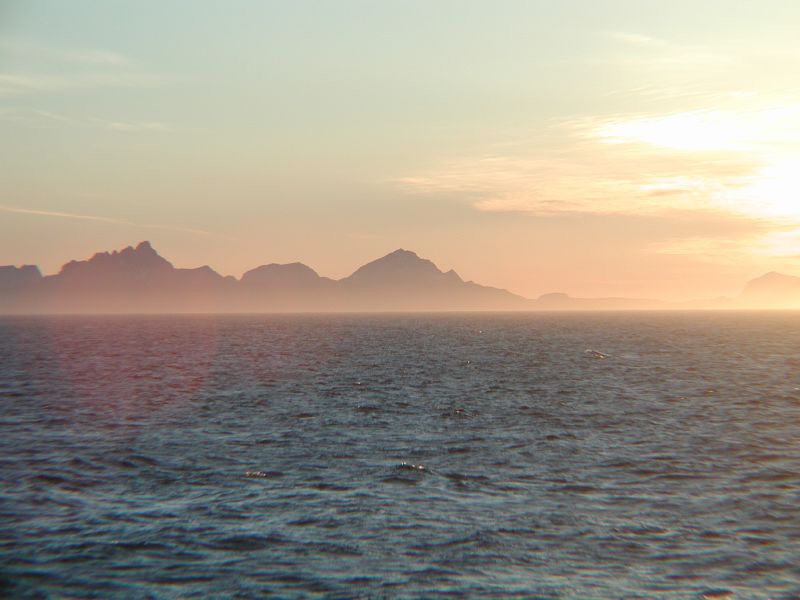 Annotation: This image was taken at 22:44 local time (1 hour east of
Greenwich). The focal length used on the digital camera was 85 mm.
This picture and the others on this page are all © 2002 by Wim van
Bochoven, the Netherlands, and are used here with his permission.
Annotation: This image was taken at 22:44 local time (1 hour east of
Greenwich). The focal length used on the digital camera was 85 mm.
This picture and the others on this page are all © 2002 by Wim van
Bochoven, the Netherlands, and are used here with his permission.
ATY remark: Note the haze layer hugging the sea. I have seen this effect
here in San Diego as well, when there is a strong thermal inversion just
above the sea surface. I believe the strong gradient in the opacity of
this haze is due to the steep temperature gradient in the surface layer,
combined with the rapid change in size of the aerosol droplets with
relative humidity: near the cold water, the air is closer to saturation
than a few meters higher up, where the temperature is several degrees
warmer.
(Don't worry about the artifact in this picture: a very dim red disk
centered near the waterline, just below the large mountain on the left.
This is a “ghost” of the overexposed Sun, due to weak reflections
between optical elements in the zoom lens.) Now the photographer
continues:
And then... suddenly it was there: this ‘band of humidity’
I thought. Quite
high from sealevel on, compared to the mountains. And in this band things
happened: ‘shades’ were growing and growing and mirroring...
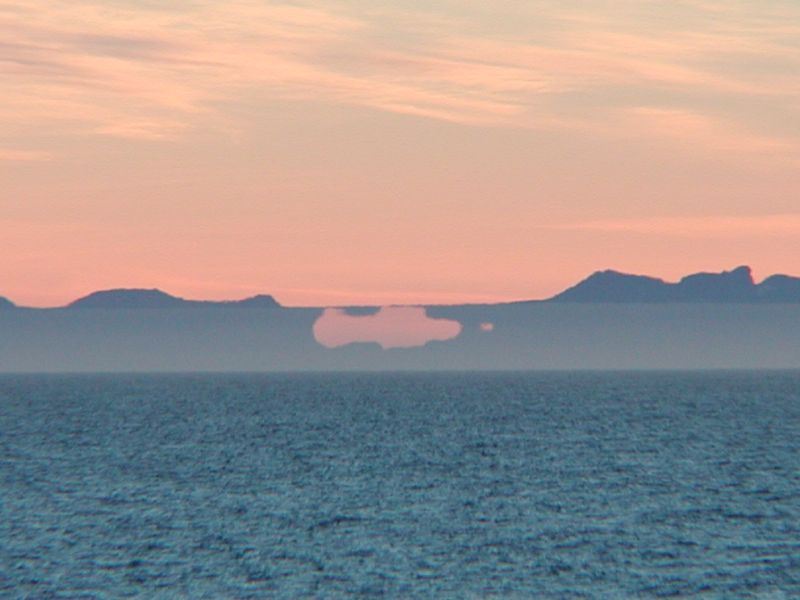 Annotation: This picture was taken at 23:29 local time, with focal length
256 mm (3× optical zoom, compared to the wide-angle shot before
sunset), plus about 2.5× enlargement of the original image.
Annotation: This picture was taken at 23:29 local time, with focal length
256 mm (3× optical zoom, compared to the wide-angle shot before
sunset), plus about 2.5× enlargement of the original image.
ATY comments: A textbook example! Noteworthy (and very typical features)
are: (1) the absolutely horizontal upper boundary of the duct that
contains the miraged images. (2) Perfectly normal appearance of the
mountains that stick up above the mirage. (3) Markedly hazy appearance of
everything in the duct. (4) Everything seen in the upper part of the duct
is an inverted image of corresponding features below; the
“fold line”
where the erect (lower) and inverted (upper) images meet is about 2/3 of
the way up from the bottom of the duct, so that (4) the inverted image is
compressed vertically, relative to the erect image.
Because of the motion of the ship, the distance to the miraged objects is
uncertain. However, objects must be beyond the horizon to appear in a
superior mirage like this. If the camera was 10 meters above the sea, the
normal
distance to the horizon
would be about 12 km; but this is surely an
under-estimate, given the strong refraction. The miraged objects are
probably all more than 20 km away.
A second image, taken just 13 seconds later, shows another section of the
mirage along the horizon to the right (closer to the Sun, which is why the
clouds are brighter here):
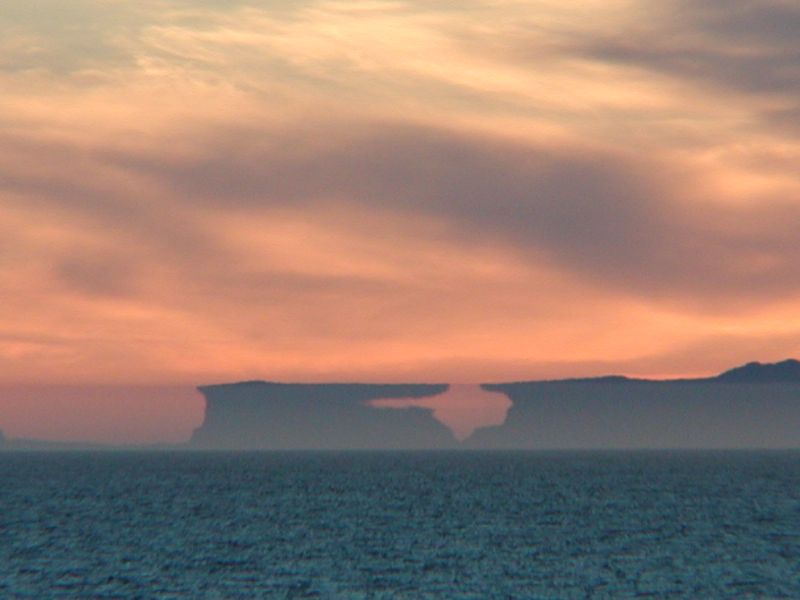
ATY comments: The fictitious “cliff” shown here is typical of these
mirages, with an apparent overhang at the top. It's really just an
inverted (and vertically stretched) image of a much gentler slope of the
land.
Although the erect and inverted features that surround the
“keyhole” in
the middle of the image are almost mirror images (apart from the
difference in vertical magnification), the correspondence is not perfect.
That's because of perspective effects: some of these features are closer
to the camera than others, but all sense of distance is lost because of
the superimposed haze in the duct. But the erect and inverted images are
seen from different directions: the eye has effectively a higher angle for
the upper (inverted) image.
Notice how the duct appears as a lighter band in front of the shadowed
ground at the right, but is seen dark against the (brighter) background
sky at the left. These effects are both due to the scattering, or
“optical thickness,” of the hazy air in the duct.
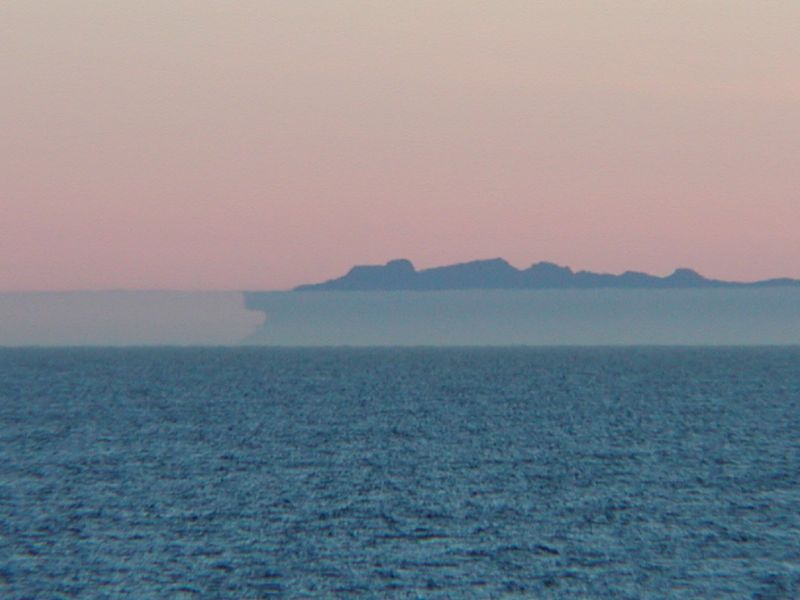 Here's a third image, taken just 17 seconds later.
The scattering effects are more pronounced here. As these images were all
taken within a minute, and the Sun is moving nearly parallel to the horizon,
the decreasing illumination is due to looking farther and farther away
from the Sun, into the part of the sky where the Earth's shadow is about
to appear.
Here's a third image, taken just 17 seconds later.
The scattering effects are more pronounced here. As these images were all
taken within a minute, and the Sun is moving nearly parallel to the horizon,
the decreasing illumination is due to looking farther and farther away
from the Sun, into the part of the sky where the Earth's shadow is about
to appear.
The Lofoten Islands angle off to the south-south-west, so as the
photographer looks more to the left, away from the Sun (which is only
a few degrees west of straight north), the islands seen are farther and
farther from the camera.
This increase in distance affects the mirage: the vertical stretching of
features becomes more marked, and vertical features become more
prominent.
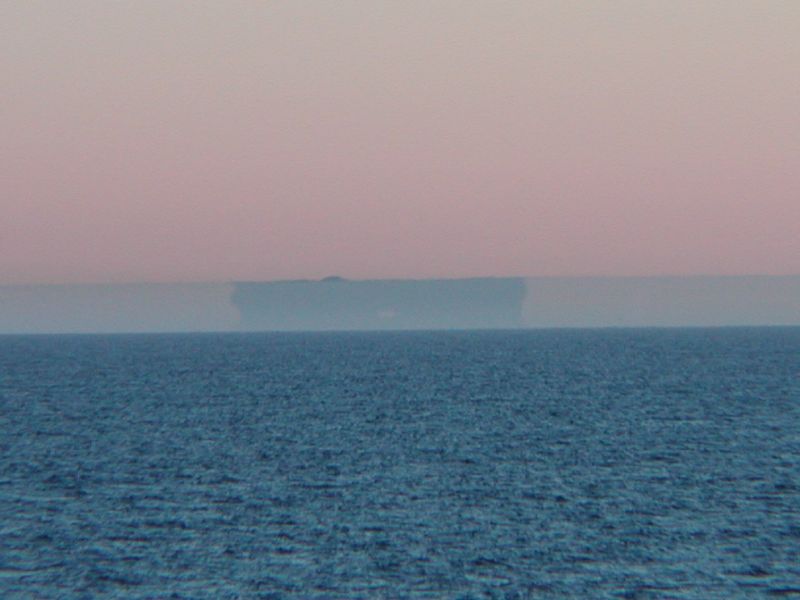 The fourth image, taken only 12 seconds after the third, is also looking away
from the Sun at a distant island. Here the effect of increasing object
distance is very strong: the sides of the image are almost vertical.
This means that the object is close to the point conjugate to the
observer, if we regard the atmosphere as acting like a cylindrical lens.
As the island is farther away, only a little of it is visible above the
duct; probably very little of it would normally be seen at this range.
The result is “looming” of land that would normally lie below the
horizon.
The fourth image, taken only 12 seconds after the third, is also looking away
from the Sun at a distant island. Here the effect of increasing object
distance is very strong: the sides of the image are almost vertical.
This means that the object is close to the point conjugate to the
observer, if we regard the atmosphere as acting like a cylindrical lens.
As the island is farther away, only a little of it is visible above the
duct; probably very little of it would normally be seen at this range.
The result is “looming” of land that would normally lie below the
horizon.
It's worth pointing out that this display took place under very nearly
ideal
circumstances. The time of the year (late Spring) is exactly the season
when superior mirages are most common: the water still has the chill of
winter, but the air is warming up. And, indeed, the observer noted that
it had been a warm day.
The air was calm: no wind to mix the cold air next to the ocean with the
warm air overlying it. The latitude was high, just above the Arctic
Circle; thermal inversions are common at high latitudes.
You could hardly ask for a better recipe for a superior mirage!
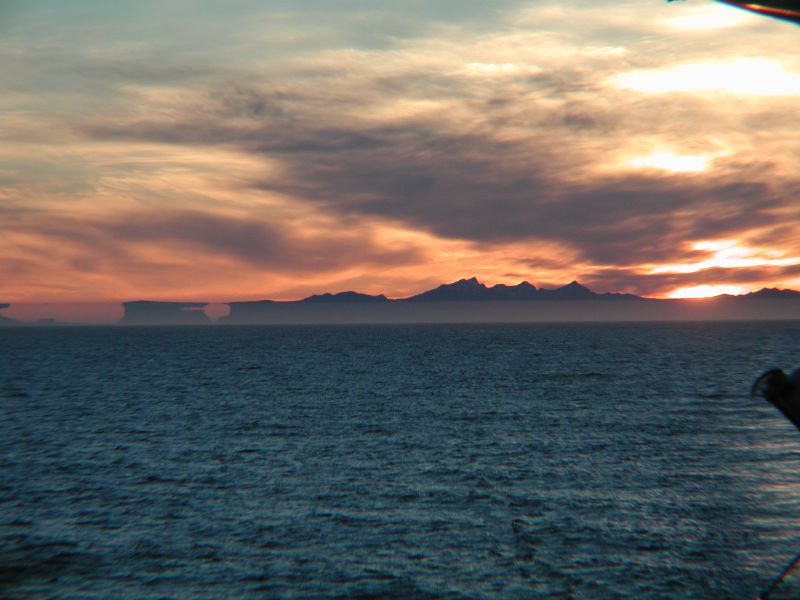 This final wide-angle shot was taken almost exactly one minute from the
first image of the mirage. It shows the setting of the “keyhole”
feature seen in the second of the mirage frames.
This final wide-angle shot was taken almost exactly one minute from the
first image of the mirage. It shows the setting of the “keyhole”
feature seen in the second of the mirage frames.
Once again, note that these pictures are copyrighted by the photographer,
and cannot be used without his permission. Thanks to him for bringing
these pictures to my attention! (And further thanks to
Olaf Squarra
for getting us together!)
— A.T.Y.
Images © 2002 Wim van Bochoven, the Netherlands
Text © 2003, 2006 – 2008, 2012 Andrew T. Young
Back to the
main mirage page
Back to the
green-flash home page
Back to the
overview page
 Annotation: This image was taken at 22:44 local time (1 hour east of
Greenwich). The focal length used on the digital camera was 85 mm.
This picture and the others on this page are all © 2002 by Wim van
Bochoven, the Netherlands, and are used here with his permission.
Annotation: This image was taken at 22:44 local time (1 hour east of
Greenwich). The focal length used on the digital camera was 85 mm.
This picture and the others on this page are all © 2002 by Wim van
Bochoven, the Netherlands, and are used here with his permission.
 Annotation: This picture was taken at 23:29 local time, with focal length
256 mm (3× optical zoom, compared to the wide-angle shot before
sunset), plus about 2.5× enlargement of the original image.
Annotation: This picture was taken at 23:29 local time, with focal length
256 mm (3× optical zoom, compared to the wide-angle shot before
sunset), plus about 2.5× enlargement of the original image.

 Here's a third image, taken just 17 seconds later.
The scattering effects are more pronounced here. As these images were all
taken within a minute, and the Sun is moving nearly parallel to the horizon,
the decreasing illumination is due to looking farther and farther away
from the Sun, into the part of the sky where the Earth's shadow is about
to appear.
Here's a third image, taken just 17 seconds later.
The scattering effects are more pronounced here. As these images were all
taken within a minute, and the Sun is moving nearly parallel to the horizon,
the decreasing illumination is due to looking farther and farther away
from the Sun, into the part of the sky where the Earth's shadow is about
to appear.
 The fourth image, taken only 12 seconds after the third, is also looking away
from the Sun at a distant island. Here the effect of increasing object
distance is very strong: the sides of the image are almost vertical.
This means that the object is close to the point conjugate to the
observer, if we regard the atmosphere as acting like a cylindrical lens.
As the island is farther away, only a little of it is visible above the
duct; probably very little of it would normally be seen at this range.
The result is “looming” of land that would normally lie below the
horizon.
The fourth image, taken only 12 seconds after the third, is also looking away
from the Sun at a distant island. Here the effect of increasing object
distance is very strong: the sides of the image are almost vertical.
This means that the object is close to the point conjugate to the
observer, if we regard the atmosphere as acting like a cylindrical lens.
As the island is farther away, only a little of it is visible above the
duct; probably very little of it would normally be seen at this range.
The result is “looming” of land that would normally lie below the
horizon.
 This final wide-angle shot was taken almost exactly one minute from the
first image of the mirage. It shows the setting of the “keyhole”
feature seen in the second of the mirage frames.
This final wide-angle shot was taken almost exactly one minute from the
first image of the mirage. It shows the setting of the “keyhole”
feature seen in the second of the mirage frames.